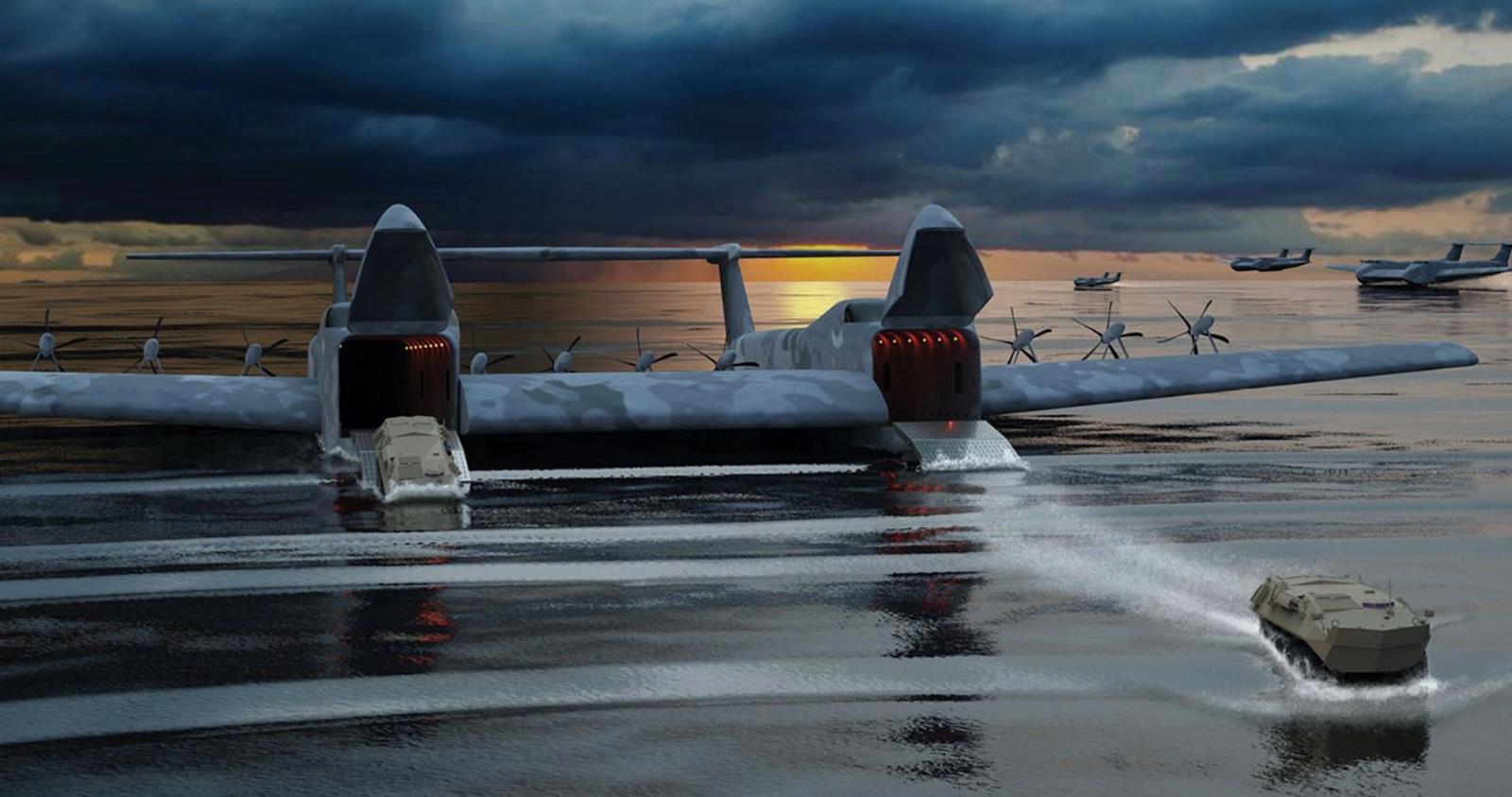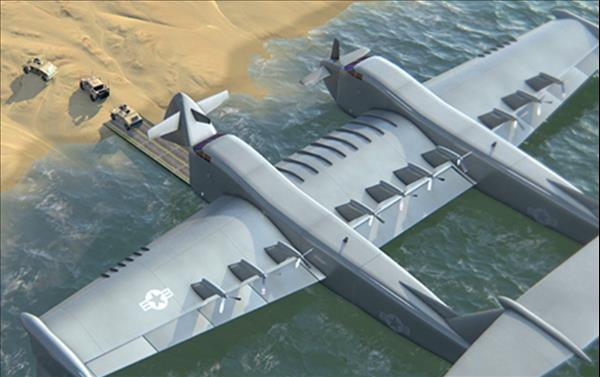(MENAFN- Asia Times) The US has unveiled concepts for a new type of amphibious flying boat, revitalizing an old idea that it hopes will revolutionize amphibious warfare.
this week, the debrief reported that the US Defense Advanced Research Projects Agency (DARPA) is pursuing the so-called“Liberty Lifter” X-Plane program to develop a large, long-range experimental flying boat with ground-effect capability for seaborne strategic and tactical heavy-lift purposes.
By flying close to the water's surface, the ground effect reduces drag and makes detection by missile radars harder due to radar clutter from the water's surface.
The report notes that the Liberty Lifter is envisioned to fly at a maximum altitude of 3,000 meters and a range of 7,400 kilometers. While in ground effect mode, it has a projected speed of 460 kilometers per hour and can carry 90 tons of cargo which it can offload using nose or tail ramps.
DARPA has selected General Atomics and Aurora Flight Sciences to develop designs for the Liberty Lifter in a US$55 million conceptual phase.
The report notes that General Atomics' design is a twin-hull, mid-wing design employing a distributed propulsion system using 12 turboshaft engines. In contrast, Aurora Flight Sciences will use a more traditional flying boat design, with a single hull, high wing and eight turboprops for primary propulsion.
DARPA hopes to select one of the designs for fabrication and assembly by 2026, start flight testing by the end of 2027 and transfer the Liberty Lifter to operational military service by 2028, as noted by the source.
Interestingly, the US has explored an ad hoc solution to fill the capability gap addressed by the Liberty Lifter.

Photo: Liberty Lifter concept via General Atomics-Aeronautical Systems, Inc / DARPA
for example, in a september 2021 article for forbes , David Axe mentioned that the US Special Operations Command had developed removable floats for its MC-130J Commando II transports, turning the aircraft into improvised seaplanes capable of taking off and landing from any reasonably smooth stretch of water to drop off or extract special forces teams.
Axe also mentions that while the US extensively operated seaplanes during World War II, they fell out of favor after the war, as the advent of the helicopter, extended range of fixed-wing aircraft, and the US' extensive network of island bases in the Pacific seemed to make seaplanes obsolete.
However, China and North Korea's advances in missile technology have forced the US to disperse the deployment of its forces to increase survivability and reduce vulnerability. In that connection, asia times reported in december 2022 that the US is building a“missile wall” consisting of land-based missile launchers stretched across its Pacific outposts and regional allies to deter China.
These outposts must be defended and incessantly resupplied to maintain a constant and high rate of fire against enemy targets. However, Axe mentions that some US island outposts lack airstrips and that helicopters lack the range and payload of fixed-wing planes, which makes seaplanes invaluable for supplying them.
Apart from resupply operations for island outposts, the Liberty Lifter may address one of the biggest challenges in mounting amphibious operations.
As noted by Guillaume Garnier in a february 2014 ifri report , the greatest vulnerability for an amphibious attacker occurs during the ship-to-shore transfer, wherein a defender can halt an amphibious assault by destroying the attacker's landing craft, thus preventing the attacker from organizing tactically and establishing a beachhead.
Garnier also notes that the defender has the advantage in amphibious operations, as it has multiple options to repel an amphibious assault such as static defenses, counterattacks against an enemy beachhead and defense-in-depth to wear down an attacker via attrition.
Advances in weaponry have potentially made seaborne amphibious assaults costly to the point of infeasibility. for example, in a june 2014 article for the diplomat , Zachary Keck points out that in amphibious operations, the attacker has to fight out in the open against a well-entrenched defender with precision-guided munitions such as anti-ship missiles and anti-tank guided missiles.
That, Keck notes, forces the attacker to station ships and disembark landing forces ashore, which extends the vulnerable period between ship-to-shore transfer.
However, amphibious operations are still the most forceful way of taking military operations into an adversary's territory. Over-the-horizon (OTH) amphibious operations may be the key to minimizing such operations' vulnerabilities and enormous costs.
Such considerations for OTH amphibious operations are not new, as Jerome Bierly and Thomas Seal discussed in a june 1991 article for the us marine corps association .

Photo: Liberty Lifter concept via Aurora Flight Sciences / DARPA
In contrast to traditional amphibious operations, Bierly and Seal note that in OTH amphibious operations beaches and landing zones are just points for entry and control measures for landing forces, emphasizing that the concept's point is to get mobile, combined arms teams ashore quickly, merge them into combat formations while on the move and drive deep into the enemy's rear positions.
They note that OTH amphibious operations remove the need to set up a beachhead to organize land combat and prepare for a massive logistics buildup, depriving the enemy of a lucrative target and eliminating the operational pause associated with landing on the beachhead and advancing to seize inland objectives.
The Liberty Lifter may thus add another dimension to the US Marine Corps' current OTH amphibious assault capabilities that are built around hovercrafts, amphibious assault vehicles and rotary-wing aircraft, complementing the strengths of these assets while offsetting their weaknesses.
in a 2020 study for the us marine corps university , Steven Yeadon notes that while hovercrafts are the only surface connectors that can carry heavy equipment at high speed, they are relatively fragile and lack the firepower and protection to assault a defended beach.
Yeadon also mentions that while amphibious assault vehicles have armor and weapons for opposed landings, they lack the range and speed for OTH operations, have insufficient protection against anti-tank weapons and are too lightly armed to take on main battle tanks.
He also says that air superiority is only sometimes assured in amphibious operations, and the threat of anti-aircraft defenses may preclude or limit aircraft use.


























Comments
No comment